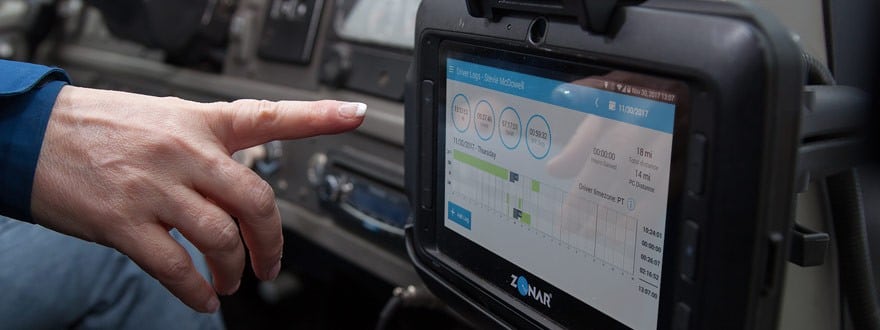Dispatch, track and monitor your drivers from a single app. It may sound too good to be true, but mobile dispatch tracking apps are the latest innovation for fleets looking to unify their fleet operations.
Mobile dispatch tracking apps allow for real-time tracking and communication, allowing managers to quickly respond to changes in the environment or to customer requests. This increases the efficiency of fleet management, reduces operational costs and drives profits.
In addition, mobile dispatch tracking apps can monitor drivers’ compliance with safety regulations, ensuring that fleets are operating within legal guidelines. The data collected from mobile dispatch tracking apps can be used to improve fleet performance in the long term by providing managers with insights into areas of improvement and areas of success.
By leveraging these insights, fleets can continue to operate at optimal levels and achieve their goals more efficiently.
GoFleet’s Mobile Dispatch App can help your fleet achieve these goals and more. In this post we’ll explore our mobile dispatch tracking app in detail; what it has to offer, and how it can take your operations to the next level.
What is a Dispatch Tracking App?
Dispatch tracking apps are digital tools designed to streamline field-based employee and asset management. They make use of various technologies, such as geotagging, scheduling, and reporting to keep tabs on business operations beyond the warehouse.
Mainly used in the logistics industry, dispatch tracking apps help fleet managers ensure that their drivers and vehicles are where they’re supposed to be at the right time.
Many of these tools come with features specifically catered to transport-based businesses, such as route optimization and driver performance tracking.
Benefits of a Dispatch Tracking App
All dispatch tracking apps come with core functionalities aimed at making fleet managers’ lives easier. First and foremost, they provide invaluable insights into how resources are being utilized, making it easy to optimize routes for maximum efficiency.
Finally, by reducing the time spent on manual paperwork and administrative tasks, businesses can save money and streamline their operations. With a dispatch tracking app, it has never been easier for companies to keep track of their employees and resources in an effective way. Below are just some of the benefits this digital solution has to offer.
Improved Visibility
Dispatch tracking apps provide fleet managers with a better understanding of their employee’s work performance, enabling them to make meaningful improvements.
With improved visibility comes improved accountability, and real-time tracking helps ensure that drivers are following their assigned routes, are aware of any potential delays, and can be located quickly in the event of an emergency.
Streamlined Communication
Dispatch tracking apps provide businesses with an effective way to streamline communication between departments and personnel. The app helps ensure that information is accurately communicated in a timely manner, eliminating the risk of delays or misunderstandings.
Automated notifications keep everyone in sync with up-to-date information on deliveries, status updates, and changes. This helps improve customer service by providing customers with accurate and timely information on their orders.
Mobile dispatch tracking apps also make it easier to assign personnel and monitor their progress, reducing reliance on manual processes and inefficiencies. Additionally, the app can provide timely data that helps businesses better understand their performance and make informed decisions about future operations.
Remote Monitoring
This latest innovation can provide companies with the remote monitoring capabilities necessary to maintain control over their operation. By giving managers and owners access to real-time information about their fleet, staff, and customers, they can respond quickly to issues that may arise, allowing them to make better decisions based on accurate data. This can help improve operational efficiency and customer service, as well as reduce unnecessary expenditure.
Furthermore, remote monitoring capabilities can promote a culture of safety by allowing stakeholders to continuously monitor their fleets for any potential issues. This is especially useful for companies with a larger fleet of vehicles, enabling them to respond quickly and appropriately in the event of an incident or emergency.
In addition, mobile dispatch tracking apps provide companies with an easy way to stay organized and ensure that all relevant information is up-to-date. By giving managers access to data on the go, they can quickly assess the current situation and keep their operations running smoothly.
Cost Savings
Having a singular, localized source of information can have a significant impact on an organization’s bottom line. For example, the app eliminates the need to purchase and maintain expensive hardware, such as on-site computers, scanners, and printers.
In addition, remote tracking can help reduce fuel costs by optimizing delivery routes and reducing idling. Fleets can also save time and money by automating paperwork tasks such as creating invoices and bills of lading. With the right app, businesses can gain real-time visibility into their operations, creating operational efficiencies and cost savings. The convenience of a mobile dispatch tracking app also helps to reduce employee downtime and increase customer satisfaction.
Enhanced Security
Using a mobile dispatch tracking app provides enhanced security, making it easier to monitor and track assets as they move from place to place. The app can be configured to alert administrators when an asset is in an unauthorized location or has been idle for too long. This feature helps ensure that valuable items are being used and managed appropriately.
The tracking app can also set up virtual boundaries, which can be used to generate alerts when an asset crosses a specified boundary. With this technology, businesses have a better understanding of where their assets are at all times and can take proactive steps to protect them.
This security layer helps reduce risks associated with theft, loss or misuse of company property. Dispatch tracking apps also help fleet managers better protect their vehicles and drivers.
An App to Dispatch, Track and Monitor in One Place
Due to increasing popularity, there are a number of mobile dispatch tracking apps on the market, yet as with all digital solutions, not all are created equal; often, in the mad rush to market, many offerings fall short and lack scalable, long-term features that can grow with your company.
GoFleet cloud-based Mobile Dispatch offers you the simplest solution with the greatest impact. User-friendly and adaptable, drivers can simply download the app through SMS and login with their mobile number, with minimal setup and training. Just download and go!
You also get access to powerful analytics and reporting features that help you analyze your fleet performance at a glance. You’ll be able to identify trends and patterns, as well as pinpoint areas of improvement.
Features of Our Mobile App
Mobile Dispatch is a great place to start if you’re looking for a high-quality system capable of meeting demanding business needs. We’ve built our solution with special consideration for today’s fleet managers and all the essential tools they need to make the most out of their operations.
Real-Time Tracking
Gone are the days of having to wait until the end of a business day to review your drivers’ performance. With GoFleet’s Mobile Dispatch app, you’ll be able to track your drivers and vehicles on-demand, ensuring they’re where they need to be, when they need to be there.
Easy Job Assignment and Management
The one constant is change, and this is especially evident with fleet logistics. Our app was designed to account for all the unexpected changes and disruptions that occur in your fleet operations.
Our app provides fleet managers with a streamlined platform for job assignment and management. With just a few taps of the screen, managers can edit orders, reassign tasks and manage their operations – all from the convenience of their mobile device.
Organize Your Workforce
Most fleet-based businesses have a diverse mix of vehicles, drivers, timesheets, jobs, and routes to organize.
Mobile Dispatch helps fleet managers amalgamate a number of work processes and streamline them with simple yet powerful organizational tools. Easily segment your workforce into specific departments and groups, set schedules for mileage or location, log trips and track expenses, all in one place.
Job Progress Notifications
Mobile Dispatch will automatically track jobs and update you on their progress, so you always have a clear picture of your operations and can ensure that they are running smoothly.
Not only does this help you keep your drivers on task, but it also provides a layer of transparency and accountability that can boost your service offerings and improve customer satisfaction.
Easy Driver Logs
Our app makes it easier to keep accurate driver logs and records. Drivers will be able to access their daily logs from the app, while fleet managers can quickly and easily review them from the dashboard. This ensures that driver information is up-to-date and accurate for the purposes of compliance, billing or hours of service (HOS).
Comprehensive Route Planning and Optimization
Our Mobile Dispatch app comes with comprehensive route planning capabilities, allowing fleet managers to create optimized routes tailored to the needs of their operations.
This can help reduce fuel costs, minimize idling and maximize returns – all while ensuring that drivers are operating efficiently and safely.
How It Works
We have designed Mobile Dispatch with every fleet-based business in mind. Take advantage of the straightforward onboarding and configuration process and start reaping the benefits right away.
1. Assign a Job
Pick your driver; Mobile Dispatch will send them the details and formally assign the job.
2. Track your Driver
Once your driver is ready to start his route, Mobile Dispatch will track his progress from beginning to end. Our digital solution makes it easy to monitor location, delivery status and mileage from one central location.
3. Receive and Manage Delivery Alerts
Once the trip is completed, you will receive an automated report detailing factors such as arrival and departure times, routes taken, as well as any notable driving behaviours.
GoFleet’s Mobile Dispatch app is the perfect companion for fleet managers to keep their operations running smoothly. Whether it’s assigning tasks, tracking driver progress or optimizing routes, Mobile Dispatch has you covered. Get the performance boost that comes with managing your fleet digitally. Take control of your fleet logistics – ask us how you can download the app today!









